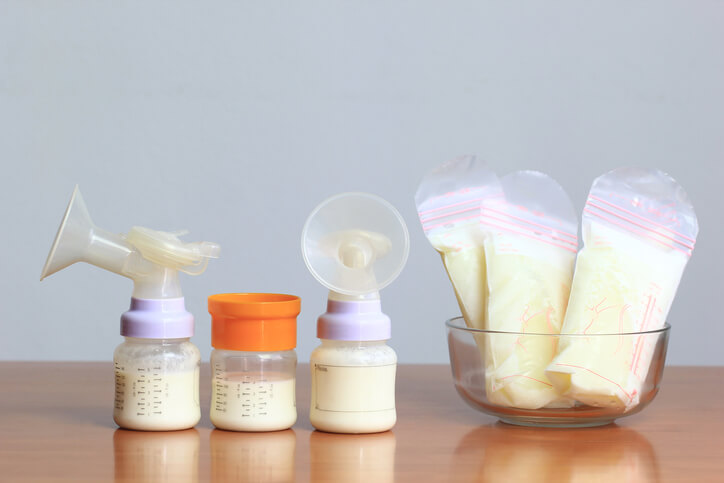Not everyone who wants to breastfeed their child can, and not every woman who produces breastmilk makes only enough for the child she is feeding. When an overabundance of breastmilk and the inability to produce meet, breastmilk donation steps in.
Breastmilk donation has existed in some form or another for centuries. Where wet nurses used to physically breastfeed extra children in the past, parents today have the convenience of having donated breastmilk shipped to their house.
Donated breastmilk is commonly used even among women who conceive and carry their own children, but it’s doubly important in surrogacy. If an intended parent doesn’t want to or cannot induce lactation, but still wants to give their child the benefits of breastmilk, milk banks step in to help out.
We know this topic can be confusing, so we’ve tackled some of the biggest concerns and questions you may have below. For more information, please call our specialists at 1-800-875-BABY(2229) or contact a local milk bank.
How Does Breastmilk Donation Work?
When it comes to donated breastmilk, safety is always the number one priority. It’s ill-advised to donate or obtain breastmilk outside of an official milk bank; there is simply too much possibility for contamination that could ultimately hurt the baby.
Official milk banks such as the Human Milk Banking Association of North America and La Leche League International require donors to pass certain screenings and requirements prior to giving their breastmilk. Typically, donors must:
- Commit to a minimum donation amount (usually around 200 ounces)
- Complete a phone interview and written health history questionnaire
- Receive doctor’s approval from their personal doctor and the baby’s pediatrician (if applicable)
- Meet certain health requirements, including abstaining from smoking and drinking
- Submit breastmilk for screening and testing, to confirm its safety and quality
After a donor passes the screening tests, the milk bank will send her an insulated box with materials to collect and freeze the milk. Once it is collected back at the bank, it is typically thawed and mixed with milk from other donors to get the optimum balance of nutrients. The milk is then tested again, put into bottles, pasteurized and screened for bacteria.
Only after all of this is completed can donated breastmilk be distributed. It may be sent to hospitals or purchased by individuals for use. Some nonprofit milk banks will only offer donated milk to individuals once they have met the needs of premature babies and babies with other serious medical conditions currently hospitalized.
If You’re a Surrogate:
If you are considering donating your breastmilk after your surrogacy journey, we encourage you to speak with your surrogacy specialist. If you haven’t already talked to your intended parents about this desire, it’s a good idea to discuss it with them, too — they may be willing to accept your donation and pay you extra compensation for it.
Not all intended parents want donated breastmilk, and that’s OK. Their decision is not a comment on you as a surrogate. If they decline your offer, you can still help other new parents by donating your breastmilk through your hospital or a nonprofit milk bank.
Before you make this commitment, talk to your doctor. They can evaluate your health and ensure that this path is the best one for you.
You should also ask yourself these questions:
- Can I commit to pumping a minimum of breastmilk as defined by the milk bank I use?
- Am I ready for the time commitment of pumping throughout the day and the night?
- Am I prepared for the extra steps of washing and sanitizing pumps and bottles more than I might when pumping for my own child?
- Am I mentally and physically healthy enough for this commitment?
Not every surrogate chooses to pump and donate her milk, and that’s OK. If you would rather stop your production, let your doctor know during your pregnancy. She can help you get the medication you need to safely and comfortably suppress lactation.
If You’re an Intended Parent:
If you are an intended mother, it’s likely that you want to try inducing lactation before buying donated breastmilk. After all, you’ve already missed out on the pregnancy experience, and don’t want to miss out on the bonding experience of breastfeeding, too.
It’s actually very common for intended parents to breastfeed their own children. But, just as women who naturally produce breastmilk do, intended parents can have difficulties lactating, as well. It’s a good idea to have a backup plan if this occurs with you: Will you switch to formula, or would you like your surrogate to pump milk for you?
Many surrogates are happy to pump milk for their intended parents. You will be expected to compensate her for her time and effort, and this should be a discussion that happens as part of your surrogacy contract. Asking your surrogate to donate her breastmilk will likely be a better path than trying to buy breastmilk from a donation bank, due to supply and demand inequalities in the industry.
If you are interested in having your surrogate pump for your baby, please reach out to your surrogacy specialist. They can help mediate this conversation and ensure all parties are comfortable with the agreement going forward.
Follow our Instagram to hear from surrogates and intended parents about what their journey was like.
